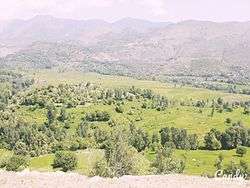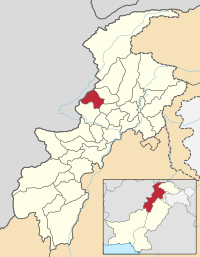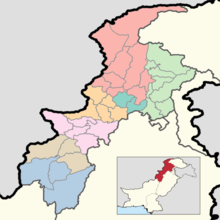Bajaur District
Bajaur District (Pashto: باجوړ ولسوالۍ, Urdu: ضِلع باجوڑ) is a district in Malakand Division of Khyber Pakhtunkhwa province in Pakistan. Until 2018, it was an agency of the Federally Administered Tribal Areas, then during restructuring that merged FATA with Khyber Pakhtunkhwa, it became a district. According to the 2017 census, the population of the district is 1,093,684. It borders Afghanistan's Kunar Province with a 52 km border. The headquarters of the agency administration is located in the town of Khaar.
Bajaur باجوړ | |
|---|---|
District | |
 | |
 | |
| Coordinates: 34°41′N 71°30′E | |
| Country | Pakistan |
| Province | Khyber Pakhtunkhwa |
| Administration HQ | Khaar |
| Government | |
| • The Political Agent | Muhammad Usman (DMG/PAS Officer) |
| • Additional Political Agent | (Vacant) |
| • Assistant Political Agent (Khaar) | Jan Mohammad (PMS Officer) |
| • Assistant Political Agent (Nawagai) | Anwar-ul.Haq Khan(PMS Officer) |
| • The Commandant Bajaur Scouts | Colonel Rekhman Kadir Khan |
| Area | |
| • Total | 1,290 km2 (500 sq mi) |
| Population (2017)[3] | |
| • Total | 1,093,684 |
| • Density | 850/km2 (2,200/sq mi) |
| Demonym(s) | Bajauri |
| Time zone | UTC+5 (PST) |
| • Summer (DST) | UTC+6 (PDT) |
| Main language | Pashto (99.5%)[4] |
| Number of Tehsils | 7 |
Bajaur is inhabited almost exclusively by Tarkani (Tarkalani) Pashtuns, and there are their main sub-tribes in Bajaur: Utmankhel, Tarkalanri (Mamund, Kakazai, Wur and Salarzai) as well as a small population of Safis. The Utmankhel are at the southeast of Bajaur, while Mamund are at the southwest, and the Tarkani are at the north of Bajaur. Its border with Afghanistan's Kunar province makes it of strategic importance to Pakistan and the region. Gujar are also present.
Geography
Bajour is about 45 miles (72 km) long by 20 miles (32 km) broad. It lies at a high elevation to the east of the Kunar Valley of Afghanistan and Pakistan, from which it is separated by a continuous line of rugged frontier hills, forming a barrier that is easily passable at one or two points. The old road from Kabul to Pakistan ran through the barrier before the Khyber Pass was adopted as the main route. Nawagai is the chief town of Bajour; the Khan of Nawagai was previously under British protection for the purpose of safeguarding of the Chitral road.[5] Major towns are Khaar and Inayat Killi.
To the south of Bajour District is the wild mountain district of the Mohmand District. To the east, beyond the Panjkora River, are the hills of Swat District, dominated by another Pashtun group. To the north is an intervening watershed between Bajour and the small tehsil of Dir. It is over this watershed and through the valley of Dir, that the new road from Malakand and the Punjab runs to Chitral.
An interesting feature in the topography is a mountain spur from the Kunar range, which, curving eastwards, culminates in the well-known peak of Koh-i-Mor, which is visible from the Peshawar valley. It was here, at the foot of the mountain, that Alexander the Great founded the ancient city of Nysa and the Nysaean colony, traditionally said to have been founded by Dionysus. The Koh-i-Mor has been identified as the Meros of Arrian's history—the three-peaked mountain from which the god issued.[5]
The drainage of Bajour flows eastwards, starting from the eastern slopes of the dividing ridge, which overlooks the Kunar and terminating in the Panjkora river, so that the district lies on a slope tilting gradually downwards from the Kunar ridge to the Panjkora.
Jandol, one of the northern valleys of Bajour, has ceased to be of political importance since the 19th century, when a previous chief, Umra Khan, failed to appropriate himself Bajour, Dir and a great part of the Kunar valley. It was the active hostility between the amir of Kabul (who claimed sovereignty of the same districts) and Umra Khan that led, firstly to the demarcation agreement of 1893 which fixed the boundary of Afghanistan in Kunar; and, secondly, to the invasion of Chitral by Umra Khan (who was no party to the boundary settlement), and the siege of the Chitral fort in 1895.[5]
Administration
Bajaur district is currently subdivided into seven Tehsils or Sub-divisions:[3]
History and events
Ancient history
The area was the site of the ancient Scythian kingdom of Apraca from the 1st century BCE to the 1st century CE, and a stronghold of the Aspasioi, a western branch of the Ashvakas (q.v) of the Sanskrit texts who had earlier offered stubborn resistance to the Macedonian invader Alexander the Great in 326 BCE. The whole region came under Kushan control after the conquests of Kujula Kadphises during the first century CE.[6][7]
Babur's attack on Bajaur
In 1518, Babur had invested and conquered the fortress of Bajaur, The Gabar-Kot from Sultan Mir Haider Ali Gabari the Jahangirian Sultan and gone on to conquer Bhera on the river Jhelum, a little beyond the salt ranges. Babur claimed these areas as his own, because they had been part of Taimur's empire. Hence, "picturing as our own the countries once occupied by the Turks",[8] he ordered that "there was to be no overrunning or plundering [of the countryside]".[8] It may be noted that this applied to areas which did not offer resistance, because earlier, at Bajaur, where the Pashtun tribesmen had resisted, he had ordered a general massacare, with their women and children being made captive.[8]
Babur justifies this massacre by saying, "the Bajauris were rebels and at enmity with the people of Islam, and as, by heathenish and hostile customs prevailing in their midst, the very name of Islam was rooted out...".[9]
As the Bajauris were rebels and inimical to the people of Islam, the men were subjected to a general massacre and their wives and children were made captive. At a guess, more than 3,000 men met their death. We entered the fort and inspected it. On the walls, in houses, streets and alleys, the dead lay, in what numbers! Those walking around had to jump over the corpses.[10][lower-alpha 1]
Recent decades
During the Soviet invasion in the 1980s, the area was a critical staging ground for Afghan and local mujahideen to organise and conduct raids. It still hosts a large population of Afghan refugees sympathetic to Gulbuddin Hekmatyar, a mujahideen leader ideologically close to the Arab militants. Today, the United States believes militants based in Bajaur launch frequent attacks on American and Afghan troops in Afghanistan.} An aerial attack, executed by the United States targeting Ayman al-Zawahiri, took place in a village in Bajaur Agency on January 13, 2006, killing 18 people.[11] Al-Zawahiri was not found among the dead and the incident led to severe outrage in the area. On October 30, 2006, 80 people were killed in Bajaur when Pakistani forces attacked a religious school they said was being used as a militant training camp.[12] There are many unconfirmed reports that the October attack was also carried out by the United States or NATO forces, but was claimed by Islamabad over fears of widespread protest similar to those after the US bombing in January 2006.[13] Maulana Liaqat, the head of the seminary, was killed in the attack. Liaqat was a senior leader of the pro-Taliban movement Tanzim Nifaz Shariat Mohammadi (TNSM), that spearheaded a violent Islamic movement in Bajaur and the neighbouring Malakand areas in 1994. The TNSM had led some 5,000 men from the Pakistani areas of Dir, Swat and Bajaur across the Mamond border into Afghanistan in October 2001, to fight US-led troops. In what is thought to be a reprisal for the October strike in Bajaur, in November, a suicide bomber killed dozens in an attack on an army training school in Khyber-Pakhtunkhwa.[14]
A military offensive by the military of Pakistan was launched in early August 2008 to retake the border crossing near the town of Loyesam, 12 km from Khaar[15] from militants loyal to Tehrik-e-Taliban, the so-called Pakistani Taliban.[16] In the two weeks following the initial battle, government forces pulled back to Khaar and initiated aerial bombing and artillery barrages on presumed militant positions, which reportedly has all but depopulated Bajaur and parts of neighbouring Mohmand Agency, with an estimated 300,000 fleeing their homes.[16] The estimate of casualties ran into the hundreds.[16] The offensive was launched in the wake of Prime Minister Yousuf Raza Gilani's visit to Washington in late July, and is believed by some to be in response to U.S. demands that Pakistan prevent the FATA being used as a safe haven by insurgents fighting American and NATO troops in Afghanistan.[16] However, the offensive was decided by the military, not the civilian government.[17] The bloody bombing of Pakistan Ordnance Factories in Wah on August 21, 2008, came according to Maulvi Omar, a spokesman for the Pakistani Taliban, as a response to the Bajaur offensive.[18][19]
After nine months of vigorous clashes between government security forces and Taliban, military forces have finally claimed to have forced militants out of Bajaur Agency, and advanced towards strongholds of Taliban in the region. According to figures provided by the Government of Pakistan, 1,600 militants were killed and more than 2,000 injured, while some 150 civilians also died and about 2,000 were injured in the fighting. The military operation forced more than 300,000 people to flee their homes and take shelter in IDP camps in settled districts of the province. To date, more than 180,000 IDPs have returned to their homes in Bajaur Agency, facing widespread destruction to their lives, livelihoods and massive unemployment.
In August, 2012, the Pakistani Army de-notified Bajaur as conflict zone.[20]
See also
- Bajaur Campaign
- Damadola airstrike of January 13, 2006
- Chenagai airstrike of October 30, 2006
- Bajaur offensive
- Kakazai
- Salarzai
Notes
- Thomas Holdich writing in 1911 in Encyclopædia Britannica (11th ed.) stated that "The Gazetteers and Reports of the Indian government contain nearly all the modern information available about Bajour. The autobiography of Baber (by Leyden and Erskine) gives interesting details about the country in the 16th century. For the connexion between the Kafirs and the ancient Nysaeans of Swat, see R. G. S. Journal, vol. vii., 1896" (Holdich 1911).
- Khan, Masood (2007-08-07). "Taliban-jirga talks fail in Bajaur Agency". Daily Times. Lahore, Pakistan. Retrieved 2008-09-01.
- Historical and administrative profile of the Bajaur Agency (.fata.gov.pk)
- "DISTRICT AND TEHSIL LEVEL POPULATION SUMMARY WITH REGION BREAKUP [PDF]" (PDF). www.pbscensus.gov.pk. 2018-01-03. Archived from the original (PDF) on 2018-03-26. Retrieved 2018-03-25.
- PCO 1998, p. 18.
- Holdich 1911.
- Hill, John E. (2015-03-18). "Appendix G". Through the Jade Gate - China to Rome'. II (2nd ed.). pp. 65–75.
- Yu, Taishan (1998). A Study of Saka History. Sino-Platonic Papers No. 80. Philadelphia, PA, USA: Dept. of Asian and Middle Eastern Studies, University of Pennsylvania. p. 160.
- Chandra, p. 22.
- Chandra, p. 23.
- Babur, p. 207.
- "Pakistani elders killed in blast". London, UK: BBC News. 2007-02-05.
- Khan, M. Ilyas (2006-10-30). "'Shock and awe' on Afghan border". London, UK: BBC News.
- "Pakistan's Tribal Areas". New York, NY, USA: Council on Foreign Relations. 2007-10-26. Archived from the original on 2009-05-30. Retrieved 2018-04-09.
- "Suicide bomber attacks policemen". London, UK: BBC News. 2006-11-17.
- Khan, Hasbanullah (AFP) (August 8, 2008). "Bajaur battle kills 10 troops, 25 militants". Daily Times. Lahore, Pakistan. Archived from the original on 2008-10-07. Retrieved 2008-08-24.
- Cogan, James (August 23, 2008). "Military offensive displaces 300,000 in north-west Pakistan". Oak Park, MI, USA: World Socialist Web Site. Retrieved 2008-08-24.
- Sappenfield, Mark (2008-09-24). "U.S. and Pakistan: different wars on terror". The Christian Science Monitor. Boston, MA, USA.
- Anthony, Augustine (2008-08-21). "Blasts near Pakistan arms plant kill 59". London, UK: Reuters. Retrieved 2008-08-21.
- "Pakistan: 100 die in 'Taliban' suicide bombings". CNN International. 2008-08-21. Retrieved 2008-08-21.
- Ali, Zulfiqar (2012-08-06). "South Waziristan operation: Only Sararogha cleared in three years". Dawn. Karachi, Pakistan: Pakistan Herald Publications.
References
- Babur, Zahir Uddin Muhammad, Babur-Nama: Journal of Emperor Babur, Penguin
- Chandra, Satish, Medieval India (Part two), pp. 22–23
- Profiles of Pakistan's Seven Tribal Agencies
- 1998 Census report of Bajaur Agency. Census publication. 137. Islamabad: Population Census Organization, Statistics Division, Government of Pakistan. 2001.
- Attribution

